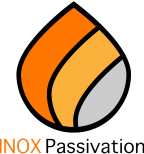The term ‘rouging’ is used to describe a variety of staining issues commonly found in high purity equipment such as WFI & pure steam systems, process vessels and autoclaves, etc.
It typically presents itself in one of three forms:
Type 1 – a pale yellow, orange discolouration on the surface that smears when wiped;
Type 2 – orange/red discolouration which is more tenacious;
Type 3 – purple / black discolouration (commonly found in hot steam systems) that can be very difficult to remove.
Biofilms are usually found in water systems. If undetected and allowed to develop, they can become quite complex and difficult to remove.
A biofilm can be made up of any number or types of bacteria. The material of the pipework system needs to be considered when choosing a chemical solution. For example, sodium hypochlorite can be very effective on biofilm, but it is potentially very damaging to stainless steel surfaces. Consequently, there is rarely one solution that fits all.
We have a range of products that can be tailored to your individual situation. From the familiar sodium hydroxide, peracetic acid and hydrogen peroxide options, to other, more technical solutions using chlorine dioxide and highly formulated alkaline-based products.
Oxygen rich environments need to be scrupulously clean. Combustible hydrocarbon containing debris (such as oils, dust, paper, etc.) must be completely removed from your equipment.
A spark or ignition inside a concentrated oxygen system can result in an explosion.
Dependent upon the starting condition of your system, there are a variety of methods and testing protocols that can be employed to meet the required standards.
These are referenced in industry standard specifications such as: CGA G-4/1 and ASTM G-93 amongst others.
INOX Passivation are able to satisfy these requirements and certify your parts/system for oxygen use.
In order to validate the effectivity of your vessel spray-ball coverage, we can carry out riboflavin testing. Riboflavin testing provides a highly visible indication of fluid coverage and will immediately identify a damaged, blocked, incorrectly specified or badly positioned spray-device.
A food-grade fluorescent reagent is applied to the vessel surfaces and a standard cleaning cycle is carried out, using just water. The vessel surfaces are then inspected using a U.V. light (at a specific wavelength). If full coverage has been achieved, there should be no fluorescence during the inspection.
Contact us now for a full and comprehensive service, in accordance with ASME BPE non-mandatory Appendix L ‘Spray Device Coverage Testing’.
Our products are specially formulated for the food and pharmaceutical industries.
The alkaline degreasers are phosphate free, non-foaming, chlorine free and contain no surfactants.
We offer a variety of acid cleaners and passivating liquids. These contain no halides and are significantly more gentle on your materials than industry go-to’s such as 20% nitric acid or pickling products. They have been tested to show that they improve the natural passive layer, with a significantly increased ratio of chromium oxide to iron oxide.
All of our products have specific and validated analytical methods for the detection of potential residues. So once we’ve finished, we can prove that we’ve left nothing behind.
